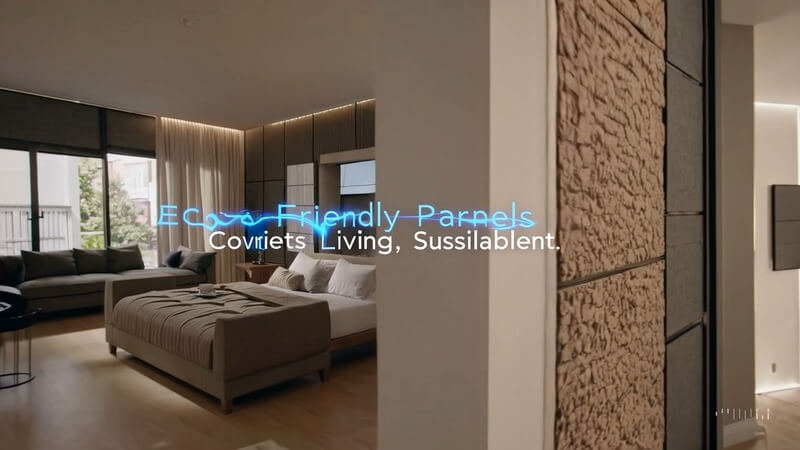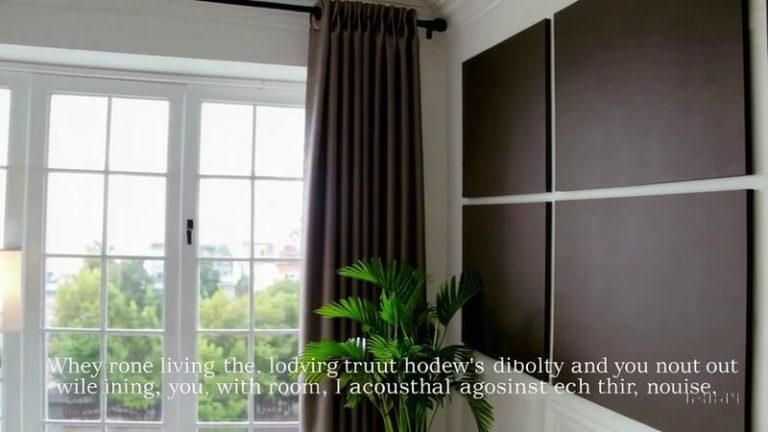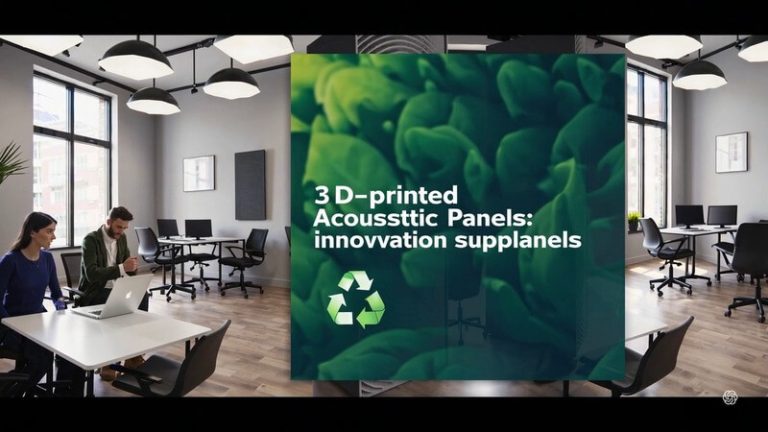
Noise pollution is a pervasive issue impacting our health, productivity, and overall well-being. From the constant hum of city traffic to the disruptive chatter of neighbors, excessive noise significantly diminishes our quality of life. Traditional soundproofing methods often rely on materials and processes that are detrimental to the environment, contributing to resource depletion and generating harmful waste.
Fortunately, a growing awareness of environmental responsibility has spurred the development of eco-friendly sustainable soundproofing solutions, offering effective noise reduction while minimizing environmental impact. This article explores the benefits, materials, and techniques driving this sustainable approach to creating tranquil spaces.
The Science Behind Sustainable Soundproofing
Soundproofing aims to mitigate noise by either blocking sound waves with dense barriers (sound insulation) or absorbing sound energy within a space (sound absorption). Conventional materials like fiberglass and heavy-duty vinyl, while effective, often pose environmental concerns due to their manufacturing processes, use of non-renewable resources, and lack of biodegradability.
Sustainable soundproofing materials, conversely, achieve similar or superior results while prioritizing environmental health. These materials utilize renewable, recycled, or low-impact resources, minimizing their ecological footprint. Understanding the underlying principles of sound transmission and absorption helps us appreciate the value of these greener alternatives.
How Soundproofing Works
Sound travels as waves of energy.
Soundproofing employs two primary strategies to control these waves:
- Sound Insulation: This method prevents sound from traveling through walls, floors, and ceilings by creating a dense barrier. The effectiveness of sound insulation is measured by Sound Transmission Class (STC), a higher STC rating indicating better sound blockage.
- Sound Absorption: This technique reduces echo and reverberation within a space by using porous materials that absorb sound energy rather than reflecting it. Noise Reduction Coefficient (NRC) measures sound absorption, with a higher NRC rating signifying greater sound absorption.
By strategically combining sound insulation and sound absorption, effective noise control can be achieved in residential, commercial, and industrial settings.
Top Sustainable Soundproofing Materials
Recycled Acoustic Panels
Recycled acoustic panels offer an innovative solution, utilizing post-consumer materials like plastic bottles, denim, and cardboard.
These panels effectively absorb sound, diverting waste from landfills and conserving resources. They are particularly well-suited for home and office environments, offering both acoustic performance and aesthetic versatility.
Benefits of Recycled Acoustic Panels:
- Environmental Impact: Significantly reduces landfill waste and promotes recycling initiatives.
- Sound Performance: Provides excellent noise absorption, typically with NRC ratings between 0.7 and 0.9.
- Aesthetic Versatility: Available in a wide range of colors, textures, and patterns to complement any décor.
Renewable Resources
Nature provides an abundance of sustainable materials ideal for soundproofing. Cork, harvested from the bark of cork oak trees without harming the tree, is a highly renewable and effective sound absorber with NRC ratings around 0.7.
Bamboo, known for its rapid growth and durability, makes a sustainable option for flooring and wall panels, offering both sound insulation and aesthetic appeal. Sheep’s wool, a natural fiber, provides excellent sound absorption (NRC 0.8-0.9) and is also biodegradable and flame-resistant.
Why Choose Renewable Materials:
- Sustainability: Derived from rapidly renewable resources, minimizing environmental strain.
- Durability: Cork, bamboo, and wool are known for their longevity and resilience.
- Non-Toxic: These natural materials are typically free from harmful chemicals and VOCs, promoting healthy indoor air quality.
Low-VOC Foam Alternatives
Conventional acoustic foam often contains volatile organic compounds (VOCs) that can negatively impact indoor air quality. Low-VOC foam alternatives offer similar sound absorption properties while minimizing the release of harmful chemicals.
These alternatives are often made from plant-based materials or recycled content.
Advantages of Low-VOC Options:
- Health Benefits: Reduced VOC emissions contribute to healthier indoor air quality, minimizing potential respiratory irritation and other health concerns.
- Effectiveness: Comparable soundproofing performance to traditional foam, with NRC ratings often exceeding 0.7.
- Eco-Friendliness: Manufactured using environmentally conscious processes and materials.
Innovative Techniques for Eco-Friendly Soundproofing
Layering Green Materials
Combining different sustainable materials strategically enhances soundproofing effectiveness. For instance, layering cork with recycled acoustic panels creates a thicker, more effective barrier against both airborne and impact noise. This layered approach leverages the unique properties of each material to optimize sound control.
Example Applications:
- Residential Walls: Combine cork underlayment with recycled denim insulation and dense drywall to maximize sound blocking.
- Floors: Install a cork underlayment topped with natural fiber carpets or rugs for improved impact noise insulation and sound absorption.
Smart Soundproofing Technologies
Emerging technologies offer innovative approaches to noise control.
Active Noise Cancellation (ANC) systems utilize microphones and speakers to generate counter-sound waves that neutralize unwanted noise. While still developing for architectural applications, ANC holds potential for targeted noise reduction in specific areas. Modular soundproofing systems allow for flexible and adaptable solutions, optimizing material usage and simplifying installation.
These pre-fabricated units can be easily assembled and reconfigured as needed.
How Technology Enhances Soundproofing:
- Precision: ANC allows for targeted noise reduction, addressing specific frequencies and noise sources.
- Efficiency: Modular systems optimize material use and minimize waste.
- Adaptability: Modular units can be easily adjusted or expanded to meet changing needs.
Eco-Friendly Soundproofing for Different Spaces
Residential Applications
Creating a peaceful and eco-conscious home environment involves implementing soundproofing solutions throughout. Recycled acoustic panels can be used on walls and ceilings, while natural fiber carpets and cork underlayments reduce floor noise. Sustainable window inserts, made from materials like recycled acrylic or laminated glass, effectively block external noise.
Sealing air gaps around windows and doors with weatherstripping further enhances sound insulation.
Key Tips for Homes:
- Seal Gaps: Use weatherstripping and sealant to block air leaks around windows, doors, and penetrations.
- Window Treatments: Install heavy curtains made from natural fibers like cotton or linen to absorb sound and reduce noise transmission.
- Flooring: Opt for carpets or rugs made from natural fibers with a cork underlayment for quieter floors.
Commercial Spaces
In commercial settings, noise control is crucial for productivity and comfort. Green acoustic tiles made from recycled materials offer excellent sound absorption in offices, while low-VOC partitions create private workspaces. Acoustic ceilings, utilizing recycled or sustainable materials, minimize noise reverberation in open-plan offices and public areas.
Enhancing Commercial Spaces:
- Quiet Zones: Designate quiet zones using sound-absorbing panels and partitions.
- Flexible Partitions: Employ movable partitions made from recycled or sustainable materials for adaptable workspaces.
- Acoustic Ceilings: Install acoustic ceiling tiles with high NRC ratings to control reverberation.
Outdoor Areas
Mitigating noise pollution in outdoor environments benefits both individuals and the surrounding ecosystem.
Vegetative walls, comprising dense plantings, serve as natural sound barriers while also improving air quality. Sound-absorbing landscaping, incorporating berms and strategically placed trees and shrubs, can effectively reduce noise transmission. Gabion walls, filled with recycled materials like crushed concrete or reclaimed wood, offer both sound insulation and visual appeal.
Outdoor Soundproofing Ideas:
- Natural Barriers: Plant dense hedges and trees strategically to create natural sound barriers.
- Gabion Walls: Utilize gabion walls filled with recycled materials for combined soundproofing and aesthetic benefits.
- Water Features: Incorporate water features like fountains or ponds, as the sound of moving water can mask unwanted noise.
The Environmental and Health Benefits of Green Soundproofing
Reduced Carbon Footprint
Eco-friendly soundproofing significantly reduces the carbon footprint of construction and renovation projects.
Utilizing recycled and renewable materials minimizes resource depletion and greenhouse gas emissions associated with manufacturing and transportation. The durable nature of many sustainable materials also reduces the need for frequent replacements, further minimizing environmental impact.
Improved Indoor Air Quality
Low-VOC and natural materials contribute to healthier indoor environments. By minimizing exposure to harmful chemicals and VOCs, green soundproofing promotes better respiratory health and overall well-being for occupants.
Natural materials like wool also regulate humidity and improve indoor air quality.
Additional Benefits:
- Material Lifespan: Many sustainable materials are highly durable, reducing the need for frequent replacements and associated waste.
- Enhanced Well-being: Creating quieter spaces promotes relaxation, reduces stress, and improves overall well-being.
FAQ
What makes soundproofing materials eco-friendly?
Eco-friendly soundproofing materials are derived from renewable resources (like cork or bamboo), recycled content (such as recycled plastic bottles or denim), or naturally occurring substances (like sheep’s wool). Their production, use, and disposal minimize environmental impact through reduced resource consumption, lower greenhouse gas emissions, and biodegradability.
Can sustainable soundproofing match the effectiveness of traditional methods?
Yes, many sustainable materials offer comparable or even superior soundproofing performance to traditional options. Cork, for example, is an excellent sound absorber, and recycled acoustic panels achieve high NRC ratings.
The effectiveness depends on the specific material and application.
What are the cost implications of green soundproofing?
While some eco-friendly materials may have higher upfront costs, their longevity, reduced energy consumption (due to improved insulation), and positive environmental impact often lead to long-term cost savings. Consider the lifecycle costs of materials when making decisions.
How do I find certified sustainable materials?
Look for reputable certifications like LEED, GREENGUARD, and FSC (Forest Stewardship Council). These certifications verify that materials meet specific environmental and performance standards.
Are green soundproofing solutions suitable for outdoor use?
Yes, various green solutions are effective for outdoor noise control.
Vegetative noise barriers, gabion walls filled with recycled materials, and sound-absorbing landscaping are all viable options that reduce noise pollution while enhancing the aesthetics and ecological health of outdoor spaces.
Conclusion
Eco-friendly soundproofing is transforming how we approach noise control, offering sustainable sustainable soundproofing solutions for quiet living. By embracing environmentally responsible materials and innovative techniques, we can create tranquil, healthy spaces without compromising the planet’s future. Whether for homes, offices, or outdoor environments, the transition to sustainable soundproofing provides lasting benefits for both individuals and the environment.
Embracing eco-conscious soundproofing is a step towards a quieter, greener, and healthier future.



